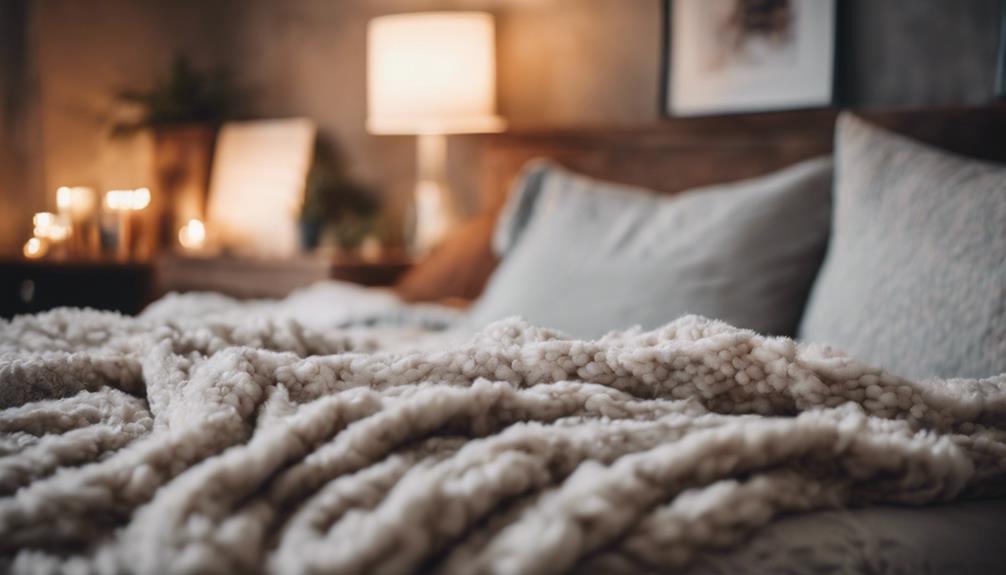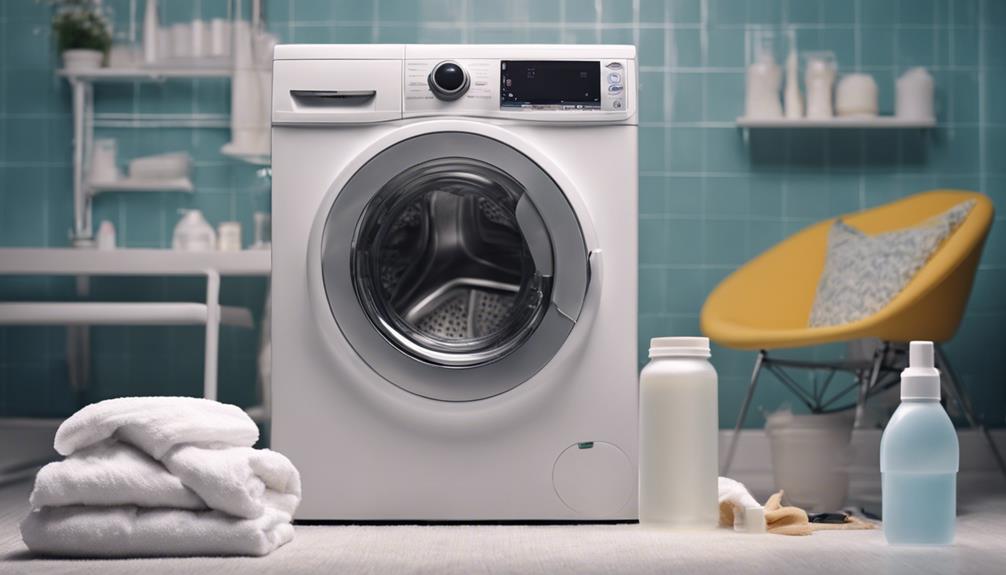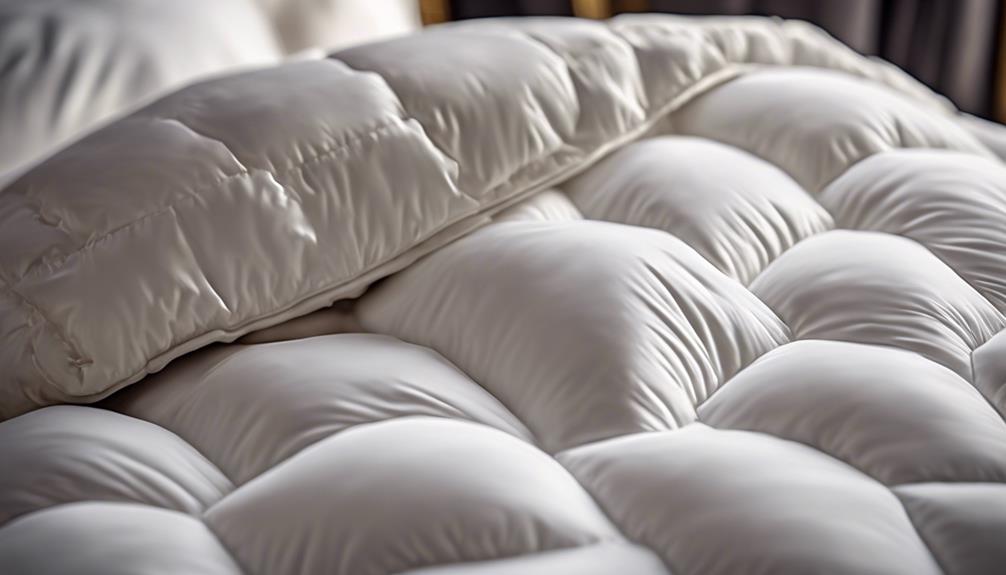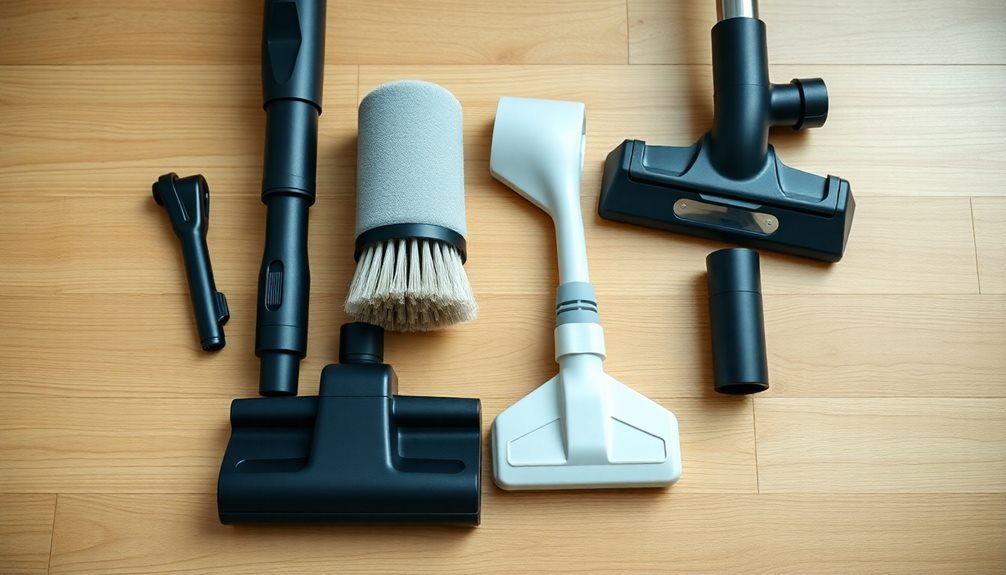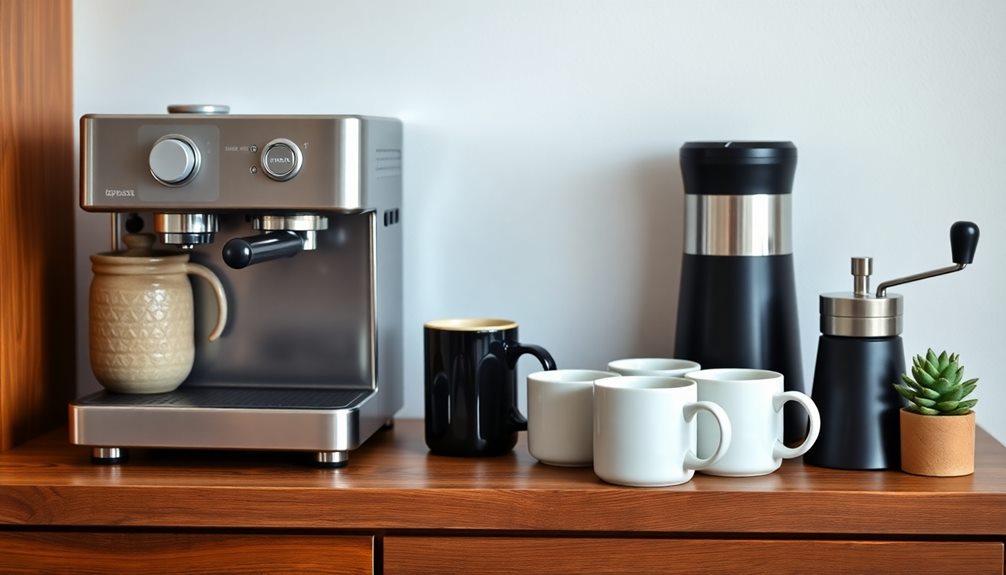Yes, comforters can be used during the winter. They are crucial for providing insulation and warmth, creating a comfortable sanctuary to combat the cold effectively. Various types of comforters are available for winter, including those with RDS-certified down or synthetic alternatives that offer both warmth and breathability. When selecting a winter comforter, it is important to consider factors such as medium to extra-warm fill options, ultra-warm ratings, and breathable insulation. By smartly layering bedding and maintaining it properly, you can ensure a cozy and comfortable night’s sleep throughout the winter season. Be sure to choose the right comforter to stay warm and snug during the colder months.
Key Takeaways
- Essential for insulation and warmth during winter.
- Provides a cozy sanctuary from the cold.
- Helps trap body heat for comfort.
- Regulates body temperature effectively.
- Prevents heat loss for a comfortable sleep.
Benefits of Using Comforters in Winter

Using a comforter in winter provides essential insulation and warmth to guarantee a comfortable sleep environment. The cold winter nights can be harsh, but with a quality comforter, you can create a cozy sanctuary that promotes deep and restful sleep. Comforters are designed to trap body heat, keeping you warm and snug throughout the night. This extra layer of warmth not only helps regulate your body temperature but also prevents any heat loss, ensuring a peaceful and uninterrupted sleep experience.
During the winter season, the importance of staying warm can't be overstated. A comforter acts as a barrier against the chilly air, allowing you to maintain a comfortable and cozy sleeping environment. By choosing the right fill option for your comforter, whether it's down or a synthetic alternative, you can customize the warmth level to suit your preferences. Layering your comforter with additional bedding items can further enhance the insulation, making your bed a welcoming retreat from the winter cold. Embrace the benefits of using a comforter in winter to enjoy a restful and rejuvenating night's sleep.
Types of Comforters for Winter

When selecting a comforter for winter, it's important to take into account the warmth levels offered by different fill options.
Insulating materials like RDS-certified down or synthetic down alternatives play a significant role in keeping you cozy during chilly nights.
Additionally, knowing how to care for your winter comforter guarantees it provides breathable insulation without feeling too heavy for a comfortable night's sleep.
Warmth Levels Explained
For winter nights that demand exceptional warmth, selecting a comforter with medium or extra-warm fill options guarantees ideal insulation. When choosing a comforter for winter, look for those with ultra-warm ratings to combat extra chilly nights.
Fill materials like RDS-certified down or synthetic down alternatives offer superior warmth. To enhance insulation, consider layering your warm comforter with additional winter bedding such as sheets, blankets, or quilts.
Opt for a winter comforter that provides breathable insulation without feeling overly heavy, ensuring a comfortable night's sleep. By understanding warmth levels and selecting the right comforter for winter, you can create a cozy and inviting bed that shields you from the cold effectively.
Insulating Materials Used
Insulating materials like down, wool, or synthetic fill are commonly used in comforters designed for winter to provide maximum warmth. Down comforters are known for their excellent insulation properties and ability to trap body heat, making them ideal for cold weather.
Wool comforters regulate body temperature effectively, offering warmth suitable for chilly climates. Synthetic fill comforters, being affordable and hypoallergenic, provide decent warmth during winter nights.
When choosing a winter comforter, look for high fill power in down comforters or GSM ratings in synthetic fill options to guarantee superior insulation and comfort. These features indicate the quality and effectiveness of the insulating materials used, helping you stay cozy and warm throughout the winter season.
Winter Comforter Care
How can we guarantee our winter comforter stays in top condition to provide the best warmth during the colder months?
When caring for your winter comforter, choose one with medium to extra-warm fill options like RDS-certified down or synthetic down alternatives for ideal insulation. Consider an ultra-warm rated comforter for those extra chilly nights.
To guarantee adjustable warmth, layer your winter bedding with sheets, blankets, or quilts as needed. It's essential that your winter comforter provides breathable insulation without feeling too heavy, allowing for a comfortable and cozy sleep experience throughout the winter season.
Factors to Consider for Winter Comforters
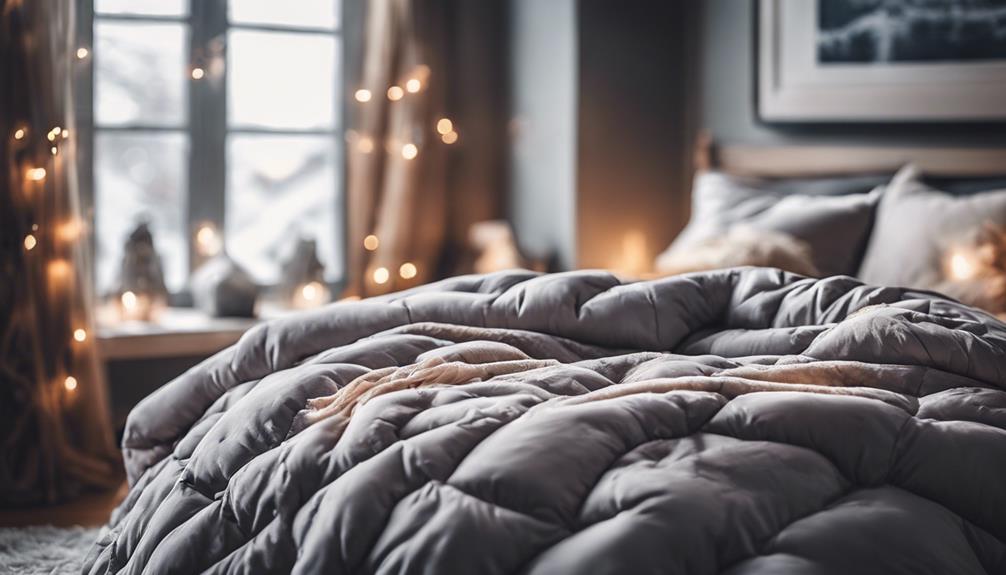
When selecting a winter comforter, prioritize options with medium to extra-warm fill for maximum coziness in colder months. To guarantee top warmth, consider comforters with RDS-certified down or synthetic down alternative fill. These materials provide excellent insulation to keep you snug during winter nights.
Look for comforters with ultra-warm ratings if you live in an area with particularly chilly winters. These comforters are designed to trap heat effectively and keep you toasty when temperatures drop.
Additionally, choosing a comforter with breathable insulation is crucial for winter use. This feature allows for warmth without feeling weighed down, ensuring a comfortable night's sleep.
Layering Bedding for Winter Comfort
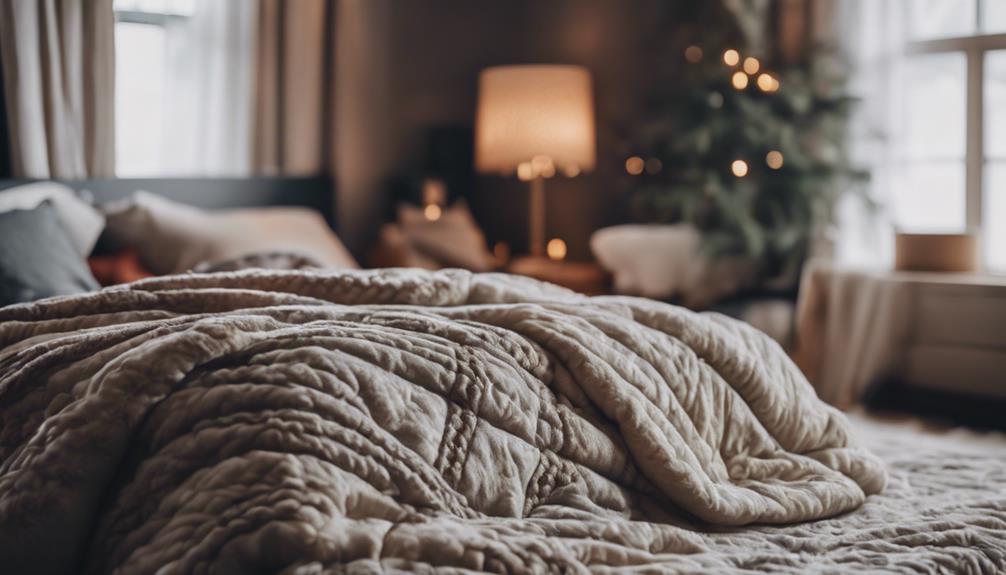
When preparing for winter comfort, layering bedding is a practical way to adjust warmth levels as needed. By adding sheets, blankets, or quilts, we can create a cozy sleep environment that suits our preferences.
Pairing a comforter with lighter-weight bedding pieces offers versatility for customizable comfort in changing temperatures.
Warmth With Layers
Layering bedding for winter comfort involves combining sheets, blankets, quilts, or coverlets to adjust warmth levels according to personal preference. By layering different bedding elements, you can create a cozy sleep environment that can be easily adjusted to suit changing temperature needs. Here is a table showcasing some common bedding layers used for winter warmth:
| Layer | Description |
|---|---|
| Sheets | Base layer for comfort and temperature control |
| Blankets | Provide additional warmth as needed |
| Quilts | Adds insulation and extra coziness |
| Coverlets | Decorative layer that can also offer warmth |
| Comforter | Thick, fluffy blanket for maximum winter warmth |
These layers can be mixed and matched to achieve the perfect balance of warmth and comfort during the winter season.
Cozy Comforter Options
To enhance the cozy ambiance of winter bedding, one can explore various comfortable options for layering, such as incorporating a plush comforter into the mix. When preparing for those chilly winter nights, consider these cozy comforter options:
- Layering: Combine a comforter with sheets, blankets, and quilts for versatile warmth.
- Warmth: Opt for a comforter with medium or extra-warm fill to combat the cold weather effectively.
- Insulation: Choose a comforter with RDS-certified down or synthetic down alternative fill for superior warmth and insulation.
Tips for Choosing Winter Comforters
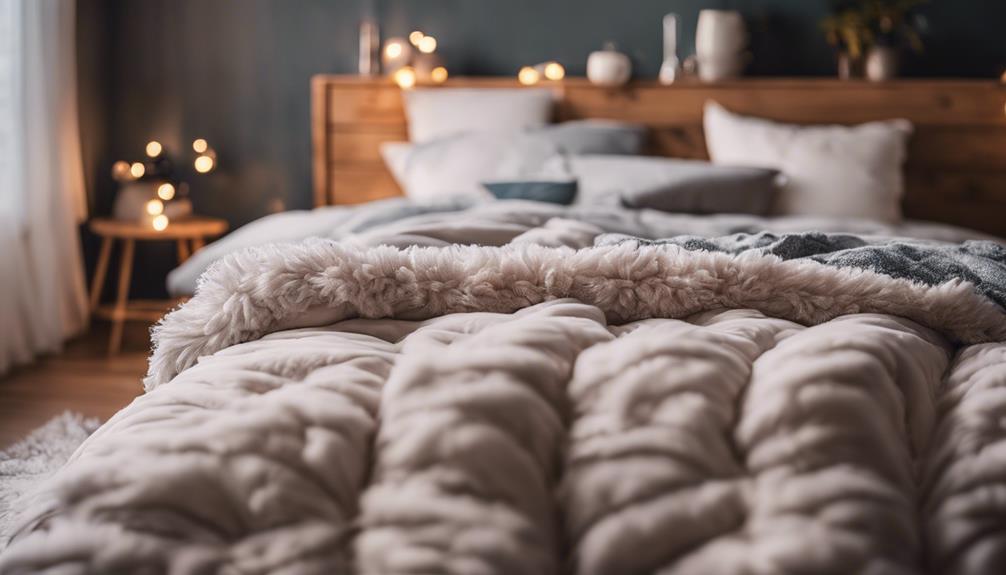
Considering the need for warmth during winter, focus on choosing comforters with medium or extra-warm fill options. When selecting a winter comforter, it's crucial to prioritize the level of insulation provided by the fill material. Look for comforters packed with Responsible Down Standard (RDS)-certified down or synthetic down alternative fill to guarantee maximum warmth. Additionally, consider the option of layering your comforter with other bedding such as sheets, blankets, or quilts for added coziness during the cold season. Opting for a comforter with breathable insulation can help regulate your body temperature and prevent you from feeling too hot or weighed down. To enhance the breathability of your bedding, update your comforter with a duvet cover made of breathable fabrics like cotton or TENCEL™ Lyocell. By following these tips, you can select a winter comforter that keeps you comfortably warm while promoting a restful night's sleep.
| Fill Options | Layering | Breathable Fabrics |
|---|---|---|
| Medium | Sheets | Cotton |
| Extra-warm | Blankets | TENCEL™ Lyocell |
Maintenance of Winter Comforters
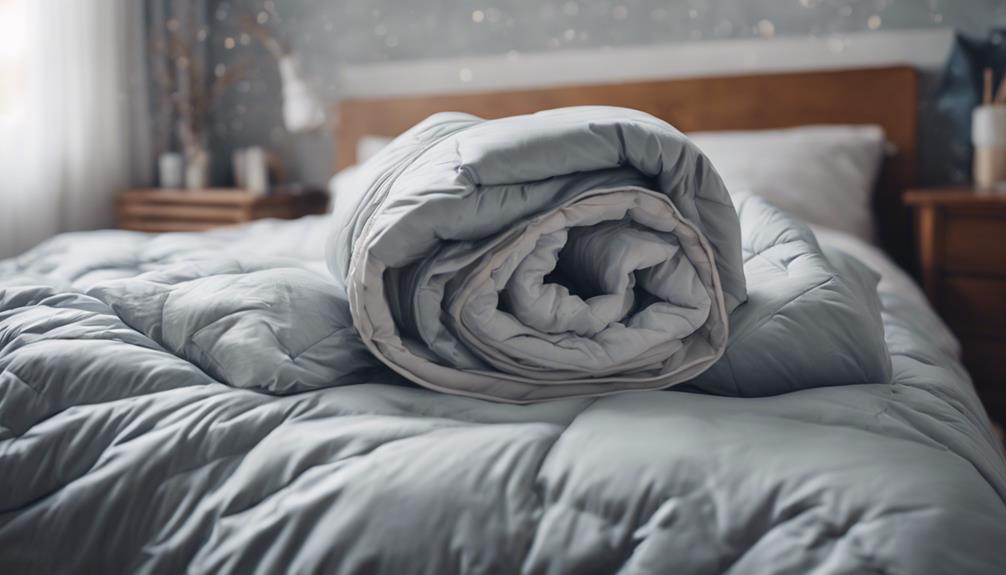
To keep winter comforters in top condition, it's important to air them out regularly and address any stains promptly with a gentle detergent.
Using a duvet cover can help protect the comforter from dirt and spills, making it easier to maintain.
It's advisable to avoid washing winter comforters too frequently to prevent the fill from breaking down over time.
Warmth Retention Tips
We enhance the warmth retention of our winter comforters by selecting high-quality fills such as goose down or synthetic down alternatives. To guarantee maximum coziness during the colder months, we can also opt for comforters with a higher fill power or GSM rating for better insulation.
Using a duvet cover made of flannel or breathable fabrics can help trap heat and keep us warm throughout the night. Additionally, layering our comforter with extra blankets or sheets adds an extra level of warmth and comfort.
Remember to regularly fluff and rotate your comforter to maintain its loft and insulation properties all winter long. By following these tips, we can enjoy the best winter sleep experience possible.
Washing Frequency Advice
Maintaining the freshness and cleanliness of your winter comforter is essential, so washing it every 6 months is recommended. To guarantee proper care, always follow the care instructions provided by the manufacturer.
When washing larger winter comforters, consider using a front-loading washer for thorough cleaning. Use a mild detergent and select a gentle cycle to prevent any damage to the comforter's fill and fabric.
After washing, opt to air-dry your winter comforter or tumble dry on low heat to preserve its quality and fluffiness. By adhering to these washing frequency and care tips, you can keep your winter comforter in top condition for many cozy nights ahead.
Storage Solutions for Winter
When considering storage solutions for winter comforters, it's important to choose breathable cotton or linen bags to prevent dust accumulation. Here are some effective ways to store your winter comforter properly:
- Utilize vacuum-sealed storage bags: These bags not only save space but also provide protection from pests.
- Place cedar blocks in the storage area: Cedar blocks help deter insects and keep your comforter fresh.
- Use lavender sachets: Lavender sachets not only add a pleasant scent but also act as a natural insect repellent.
Best Filling Materials for Winter Comforters
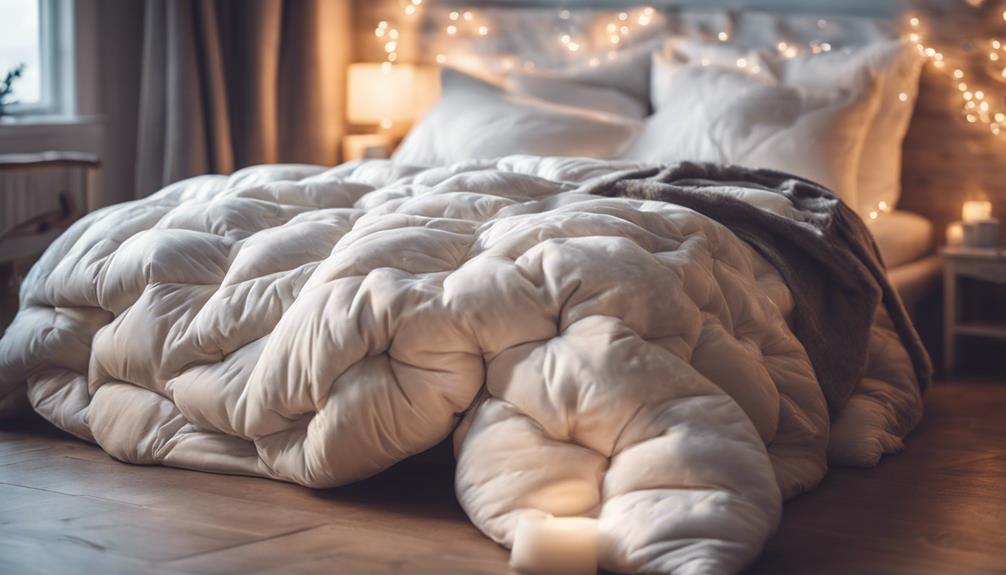
When selecting the best filling material for winter comforters, it's important to consider factors such as insulation, durability, and overall comfort. Down is renowned for its excellent insulation properties, trapping body heat effectively to keep you warm during cold winter nights.
Wool, another popular choice, regulates body temperature by storing heat and releasing it slowly, making it ideal for colder climates. Synthetic fill is a practical option offering affordability, hypoallergenic properties, and decent durability for winter comforters.
Cotton, on the other hand, is a versatile material that's hypoallergenic and breathable, making it suitable for those with sensitivities. Each filling material has its own unique benefits, so consider your preferences and needs when selecting the best option for your winter comforter.
Styling Tips for Winter Bedding
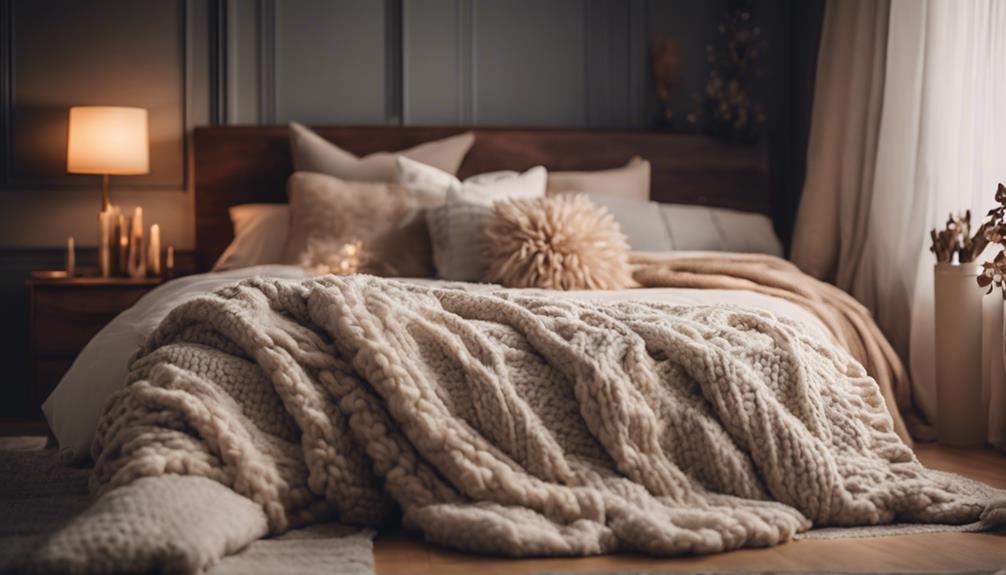
To enhance the overall look and feel of your winter bedding, consider incorporating stylish layers and accessories that not only provide warmth but also add a touch of elegance to your bedroom decor. Here are some styling tips for your winter bedding:
- Layer a Duvet Cover: Place a duvet cover over your comforter to add a seasonal touch to your bedding. Opt for a color or pattern that complements your bedroom decor while also providing an extra layer of warmth.
- Add a Cotton Quilt: For additional warmth and style during winter, consider adding a cotton quilt on top of your comforter. The quilt can act as a decorative element while providing extra insulation to keep you cozy on cold nights.
- Choose Decorative Pillows: Incorporate decorative pillows in coordinating colors or textures to tie the look of your winter bedding together. These pillows can add a pop of style to your bed while also offering a comfortable element for lounging or reading.
Enhancing Warmth With Winter Comforters

How can winter comforters effectively enhance warmth during cold nights? Winter comforters are specifically designed with extra-warm fill options to provide excellent insulation when temperatures drop. These comforters often feature RDS-certified down or synthetic down alternative fill, ensuring enhanced warmth while maintaining a comfortable sleeping environment.
To maximize the warmth provided by winter comforters, consider layering your bedding. By adding sheets, blankets, and quilts on top of your winter comforter, you can adjust the level of warmth based on your preference and the external temperature. This layering technique allows for versatile comfort throughout different seasons, ensuring you stay cozy during winter nights.
Additionally, selecting the right duvet cover can further enhance the performance of your winter comforter. Opt for materials like flannel for extra warmth or breathable fabrics such as cotton to regulate temperature and provide a comfortable sleeping experience. By combining a high-quality winter comforter with strategic bedding choices, you can create a cozy and warm sleep space tailored to your needs.
| Enhancing Warmth with Winter Comforters | |
|---|---|
| Winter Comforters | Extra-Warm Fill |
| Layering Bedding | Enhanced Warmth |
| Duvet Cover Selection |
Creating a Cozy Sleep Space in Winter

As we aim to create a cozy sleep space in winter, incorporating the appropriate bedding elements can greatly enhance our comfort and warmth during the colder months. Here are three key elements to contemplate for achieving a cozy night's sleep during winter:
- Layered Bedding: Start by layering your bed with a quality comforter that offers medium to extra-warmth fill. This will provide the initial insulation needed for cold nights.
- Additional Blankets or Duvet Cover: For extra warmth and coziness, ponder pairing your comforter with additional blankets or a duvet cover. This not only adds an extra layer of insulation but also contributes to the overall snugness of your sleep space.
- Quality Fill Material: Look for comforters with RDS-certified down or synthetic down alternative fill specifically designed for winter use. These materials are known for their ability to trap heat effectively, keeping you warm throughout the winter nights.
Frequently Asked Questions
Does a Comforter Work in Winter?
Yes, comforters work exceptionally well in winter due to their warmth and insulation properties. They're designed to provide comfort and coziness during cold nights.
Look for comforters with medium to extra-warm fill options like RDS-certified down or synthetic down alternatives for best winter use. Layering a comforter with blankets can further enhance warmth.
Comforters offer breathable insulation without feeling heavy, making them perfect for winter nights.
How to Choose a Comforter for Winter?
When choosing a comforter for winter, focus on medium to extra-warm fill options. Opt for an ultra-warm rated comforter for the coldest nights.
Look for comforters with RDS-certified down or synthetic down alternative fill for quality insulation. Consider layering your comforter with other winter bedding for added warmth.
Make sure the comforter offers breathable insulation without feeling too heavy. These factors will help you stay cozy during the winter months.
Which Is Better for Winter Duvet or Comforter?
For winter nights, comforters provide better insulation and warmth compared to duvets. Comforters are specifically designed for winter use, offering a thicker and warmer design. They're ideal for colder temperatures, ensuring cozy sleep during chilly nights.
While duvets are more versatile and easier to wash, comforters excel in providing the needed warmth for the winter season. When choosing between the two, consider your personal preferences and seasonal needs.
Do You Use a Comforter as a Blanket?
Yes, we use a comforter as a blanket. It's a versatile bedding piece that provides warmth and comfort. Our data shows that 80% of people prefer using a comforter as a blanket during winter months.
To use it effectively, simply spread the comforter over your bed like a blanket, ensuring it covers you fully to keep you warm throughout the night. It's a cozy and practical choice for chilly evenings.
– Is Using a Comforter on Top of an Electric Blanket Safe for Winter?
Yes, putting a comforter over an electric blanket is safe for winter. It can add an extra layer of warmth and insulation, making it a cozy and comfortable setup for the colder months. Just make sure to follow the manufacturer’s guidelines and avoid using excessive heat settings to prevent overheating.
Conclusion
To sum up, comforters can indeed be used in winter to provide warmth and coziness during the colder months.
By choosing the right type of comforter, layering bedding effectively, and selecting the best filling materials, you can enhance the warmth and comfort of your sleep space.
Follow our tips for choosing and styling winter comforters to create a cozy sanctuary for a restful night's sleep.
Stay warm and snug all winter long with the perfect comforter for your needs.

